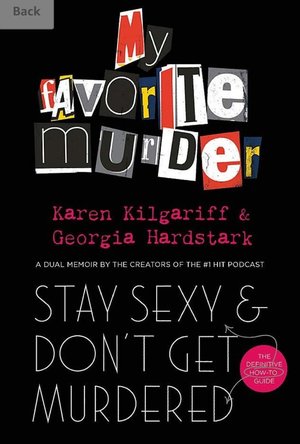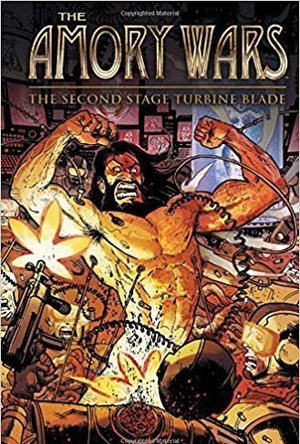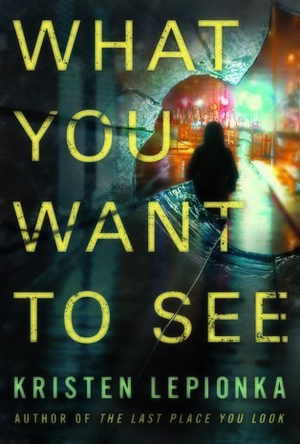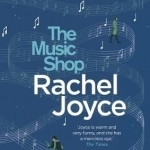
Stay Sexy and Don't Get Murdered: The Definitive How-To Guide From the My Favorite Murder Podcast
Karen Kilgariff and Georgia Hardstark
Book
The highly anticipated first book by Karen Kilgariff and Georgia Hardstark, the voices behind the #1...
True crime Murder Addiction Depression Anxiety Eating disorders
ClareR (6001 KP) rated The Saint of Lost Things in Books
Apr 12, 2023
This isn’t a happy family by any means. Lindy’s Catholic-when-it-suits-him grandfather makes it clear that he only tolerates her. He punishes her for every minor infraction because she is “the wrong child”. He punishes her because she’s illegitimate and female, and what’s more, her mother is no longer alive to take her share of the punishment. Lindy is, of course, responsible for her fathers existence - he’s a gypsy, a tinker and a whole host of other unpleasant names that I could have done without learning. In fact, Lindy is responsible for a great many things that she doesn’t know about.
The writing makes this abusive family seem almost acceptable, and at the same time, shows it up for the horror show that it is. Bronagh Waugh’s narration adds more of a wry, dark humour to what would be a relentlessly sombre story otherwise.
I felt sorry for Auntie Bell, also held in low esteem by her own father and given no option but to look after her niece. To be fair, she’s not very nice about it, and is all too keen to tell Lindy that she was forced to look after her and in doing so, Lindy ruined her life.
Lindy’s life isn’t much better. She tries to have her own life away in London, but ends up returning to the farm and her awful grandfather.
Her life changes forever when the parish priest comes to her with news she never thought she’d have. This news changes everything. And what an earth shattering piece of news it is!!
I really enjoyed this, even though it wasn’t the happiest of books. I found myself thinking about it, even when I wasn’t listening. These are all fascinating characters and brought to life so well by the narrator.
Recommended.

The Amory Wars: The Second Stage Turbine Blade
Book
Released in the summer of 2004, the comic books narrate the events of approximately the first third...
Acanthea Grimscythe (300 KP) rated Something's Alive on the Titanic in Books
May 16, 2018
A true product of its time, and remaining faithful to the time-period in which the story is set, one of the few things of note to make in regards to its characters is the absolute lack of a strong female presence. The two women that are present, especially Chaney in the 1975 portion of the book, are Mary Sue-esque and, without a doubt, sexualized. Another note to be made comes in the form of the male characters: they are portrayed as stereotypical, stubborn men that, despite being superstitious, are also skeptics. This manner of male character is more prominent in the second part of the book than the first.
The plot, on the other hand, was pretty stellar. In 1975, the expedition lacks the proper equipment to dive down into the depths of the Atlantic and explore the ship for extended periods of time. They make the most of what they do have, however. Intent on claiming the lost treasure, most of John Hawke's crew show little regard for the fact that they are desecrating a grave: greed is, after all, the heart of all evil. While the Atlantic Ocean treats the crew well, the Titanic is anything but forgiving: the decrepit ship plays host to more than the relics of the souls that once stood upon its deck. Whatever that thing is, it doesn't play nicely. In 1995, the US Navy gathers a crew to find out what exactly happened in 1975, and to complete the earlier expedition's salvage mission.
Given the presence of a female in a heavily male dominated field, it goes without saying that there's a bit of teasing and a bit of romance. That subplot is fairly minor and serves mostly to remind readers of a certain character's penchant for being a total asshole and little more. There is also sex, briefly, but I'll leave that to someone else.
Serling's knowledge of the Titanic is actually pretty accurate, down to the fact that the fourth funnel on the ship was a fake, there was a shortage of lifeboats, and most of the lifeboats were dropped before they were filled.
It isn't very often that a book really draws me in, but that could be attributed to the fact that I no longer read as I used to. Serling's prose kept me on the edge of my seat and at times, it even raised my heart rate a little. Rather than paint us an entire picture of the supernatural phenomena that takes place, he begins with little bits and pieces, crumbs if you will, until finally, you begin to question the sanity of the characters involved, whilst simultaneously hoping for the best.
Heather Cranmer (2721 KP) created a post
Nov 3, 2021

Speak & Translate - Translator
Productivity and Reference
App
Speak & Translate is an indispensable voice and text translator that allows you to communicate...

Speak & Translate Premium
Reference and Travel
App
Speak & Translate Premium is an indispensable voice and text translator that allows you to...
Kristy H (1252 KP) rated What You Want To See (Roxane Weary #2) in Books
May 10, 2018
I loved this book. I love the first person aspect. The Roxane Weary series is straight-up great mystery writing. No unreliable narrator, no chapters that alternate POV or time periods, no gimmicks--just an excellent protagonist and a strong plot. It makes you long for mysteries of old (think Kinsey Millhone). The ways I love Roxane cannot truly be enumerated--she's a female lead in a mystery series, for one. She's smart, witty, and sarcastic. She's bisexual, but this characteristic is just who she is, not her main defining element or the entire defining point of the novel. As a bisexual female, I cannot stress how amazing this is in literature. To have bisexual representation (and have that representation be intelligent, funny, and not portrayed as evil and deviant), well, it's wonderful. She has relationships of all kinds and works on figuring out herself, just like any other person. Gasp! Imagine that. I couldn't love Roxane more (or Kristen Lepionka for creating this character). Also, Roxane calls waffles "golden beauty" and well, what more do you need in your PI? She's the Leslie Knope of private investigators.
I was worried that the second Roxane Weary novel wouldn't stand up to the first, but I was anxious for no reason. The second book is just as wonderful and intricately crafted as the first, and we get to see Roxane both struggling and growing professionally and personally. The case is a great one--it had me frantically reading and totally shocked me at the end, which I love. So rarely can a detective novel keep me guessing to the anymore. Marin Strasser is quite the character, and her web of lies pulls in a whole host of supporting characters.
We also see Roxane navigating new territory with Tom, her former lover (and, as mentioned, her dad's ex-partner), and get appearances again from the appealing Weary brothers and Roxane's mom. Roxane is still working on her relationships--not just romantic ones, but life ones, and you'll be touched as she figures out trying to be a "surrogate aunt" to Shelby, who appeared in book one. Watching her let her guard down at times is enjoyable.
The case is still mainly the star, though, and it won't disappoint. It's complicated and intriguing and everything comes together in ways that will make you gasp and keep you riveted. I was definitely shocked several times while reading. Not to mention I love it when an author can write a character that I truly hate--you know they've done a good job when you can feel that anger viscerally through the pages!
Overall, I have nothing bad to say about this book. Maybe that it's over, and I have to wait now for a (hopeful!!) book three? I love Roxane. I feel kinship toward her for sure, this sarcastic, bisexual PI whose still navigating the world around her. The mystery in this book won't disappoint, nor will the characters. If you haven't read the first Roxane Weary novel, I do recommend reading it first (mostly because it's also so good), but this will stand on its own. Highly recommend!!
I received a copy of this novel from the publisher and Netgalley in return for an unbiased review. More at http://justacatandabookatherside.blogspot.com/.

My Incredible Body - Guide to Learn About the Human Body for Children - Educational Science App with Anatomy for Kids
Education and Games
App
Winner of a Parents' Choice Silver Honor Award and awarded "Best App for Teaching & Learning" from...
Hazel (1853 KP) rated The Music Shop in Books
Aug 22, 2017
From the author of The Unlikely Pilgrimage of Harold Fry comes a unique and beautiful story about music and learning how to listen. The Music Shop by Rachel Joyce takes readers on a journey through the developing music world of the late 1980s when CDs are beginning to wipe out all other means of recording music – a complete disaster for someone like Frank, the owner of the music shop, who only sells vinyl.
The book begins in 1988 in a crumbling down street where shopkeepers are barely making enough money to survive. Frank’s shop is one of the few remaining and, despite everything against him, is determined to keep going. Not only does he sell vinyl records, Frank has an empathetic gift allowing him to sense exactly what a customer needs to listen to, even though they may not realise it themselves. However, one day, Frank’s world is turned upside down by the arrival of a young German woman, Ilse Brauchmann, who faints on his doorstep.
Ilse intrigues all of the shopkeepers on Unity Street, particularly Frank’s teenaged assistant, Kit. Although Frank tries to deny it, Ilse also fascinates him to the point that he is rarely thinking of anything else. But what concerns him most is that he cannot pinpoint what piece of music she ought to listen to. When questioned, Ilse admits she knows nothing about music and begs Frank to give her lessons. These lessons have nothing to do with instruments – Frank is the least qualified to teach such a thing – but about how to listen to music. How to hear the pauses in classical pieces; understand the meaning behind Beethoven’s sonatas; feel the passion behind punk music; learn to love a number of composers for the things many people miss.
The longer Frank spends around Ilse, the more he begins to fall in love. However, love is something Frank denies himself ever since the death of his mother fifteen years previously. Written in italics are flashback chapters explaining how Frank’s love of music came about, his relationship with his mother, and how he ended up as a dead-end vinyl seller. Due to his fear of intimate relationships, Frank keeps pushing Ilse away until, one day, he realises how much he needs her. But, he may have left it too late.
The Music Shop is split into four sections, or sides (a reference to vinyl records). Side A introduces the characters and settings during a wintery January when Frank is beginning to struggle with the competition caused by the recently opened Woolworths on the nearby high street. Sides B and C focus on the development of Frank and Ilse’s friendship, the secrets they hide from each other and the foreboding sense of disaster hanging over the one-of-a-kind music shop.
As Frank begins to realise how much Ilse means to him, the sudden appearance of side D will break readers’ hearts. Whilst sides A, B and C take place in 1988, side D jumps forward 21 years to 2009. It appears Frank and Ilse never got the relationship they deserved. Two unhappy decades have been and gone, demolishing any resemblance of the way life used to be. However, because there is a side D, readers can only hope it will result in a happy ending.
The Music Shop is a love story between two quiet, modest characters whose past and present circumstances get in the way of a peaceful future. However, it is not only a piece of romantic fiction. Rachel Joyce writes a message in story format about second chances and being brave. Learning to listen does not only apply to music, it applies to hearing what other people are saying and what they are not; most importantly, the book urges people to listen to themselves.
The research undertaken for this novel is phenomenal. For starters, it is set almost thirty years ago when vinyl was only beginning to go out of fashion. The quality of music and the access people had to it was extremely different to the simplicity of today where it is possible to download everything at the press of a button. The breadth of music genre is as wide as possible. Every type of music is covered from Handel’s Messiah to Aretha Franklin and The Sex Pistols. To be able to discuss such a range without falling into stereotypes is a feat worthy of congratulating.
The Music Shop far surpasses anything Rachel Joyce has written so far. The story is fragile in a beautiful way, its delicacy causing the reader to treat it with care, rather than rush through it like some mundane piece of fiction. It will interest a whole host of readers: male and female, music lovers and those with a preference for silence. Whoever you are, be prepared to take something away from this distinctive, outstanding novel.



